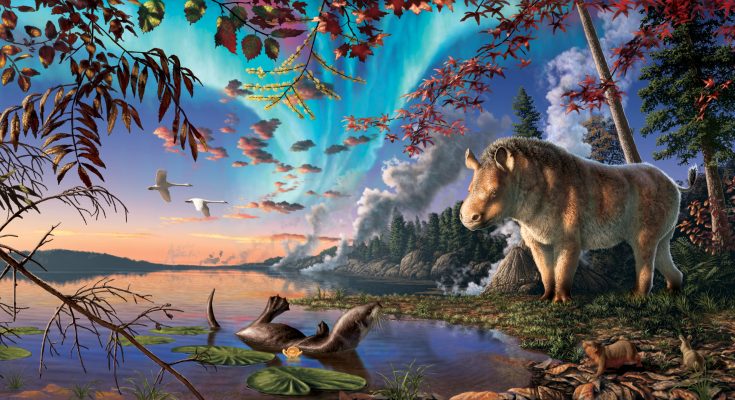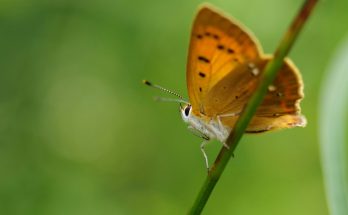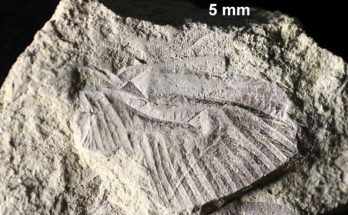Scientists from the Canadian Museum of Nature have announced the discovery and description of an extinct rhinoceros from the Canadian High Arctic. The nearly complete fossil skeleton of the new species was recovered from the fossil-rich lake deposits in Haughton Crater on Devon Island, Nunavut and is the most northerly rhino species known.
Rhinoceroses have an evolutionary history that spans more than 40 million years, encompassing all continents except South America and Antarctica. The “Arctic rhino” lived about 23 million years ago, during the Early Miocene and is most closely related to other rhino species that thrived in Europe millions of years earlier.
The scientific paper describing this new species, named Epiaceratherium itjilik [eet-jee-look], was published today in the journal Nature Ecology and Evolution.
“Today there are only five species of rhinos in Africa and Asia, but in the past they were found in Europe and North America, with more than 50 species known from the fossil record,” says the study’s lead author Dr. Danielle Fraser, head of paleobiology at the Canadian Museum of Nature (CMN). “The addition of this Arctic species to the rhino family tree now offers new insights to our understanding of their evolutionary history.”
About Epiaceratherium itjilik
Rhinocerotids came in a variety of shapes and sizes, from large and hippo-like to relatively small and hornless. Epiaceratherium itjilik was relatively small and slight, similar in size to the modern Indian rhinoceros, but lacking a horn. The Arctic specimen is thought to be early to mid-adulthood based on moderate wear of the cheek teeth.
The species name “itjilik” means “frosty” or “frost” in Inuktitut. The research team wanted to honor the rhino’s High Arctic home, so they consulted with Jarloo Kiguktak, an Inuit Elder and former mayor of Grise Fiord, the most northerly Inuit community in Canada. He has visited the fossil deposits of Haughton Crater and also participated in multiple paleontological expeditions in the High Arctic.
Most of the rhino’s bones were collected at the Haughton Crater site in 1986 by Dr. Mary Dawson. She was Curator Emeritus at Carnegie Museum of Natural History in Pittsburgh, Pennsylvania, and a trailblazer in Arctic paleontology. She had uncovered the critical diagnostic parts—the upper and lower teeth, mandibles and parts of the skull—that allowed the CMN team to define it as a rhinocerotid and a new species.Dr. Natalia Rybczynski (foreground, left) and Dr. Mary Dawson sift for fossils at the Haughton Crater site during a field expedition in 2007. Credit: Martin Lipman Canadian Museum of Nature
“What’s remarkable about the Arctic rhino is that the fossil bones are in excellent condition. They are three dimensionally preserved and have only been partially replaced by minerals. About 75% of the skeleton was discovered, which is incredibly complete for a fossil,” says paleobiologist Marisa Gilbert, study co-author and Senior Research Assistant with the CMN.
Gilbert took part in a number of research trips to the Haughton Crater in the late 2000s, which were led by Dr. Natalia Rybcynski, CMN Research Associate and another co-author of the study. These expeditions resulted in the discovery of another new species, the transitional seal ancestor, Puijila darwini.
Additional remains of E. itjilik were found on the later field expeditions led by the CMN, when Dawson joined Rybczynski and Gilbert. They were prospecting the Haughton site as follow-ups to Dawson’s fieldwork. Dawson passed away at age 89 in 2020 and is posthumously cited as the fourth author on the study.Marisa Gilbert (left) and Dr. Danielle Fraser with the fossil of Epiaceratherium itjilik laid out in the collections of the Canadian Museum of Nature. Credit: Pierre Poirier Canadian Museum of Nature
The biogeography story
The presence of this new Arctic species was an impetus for the research team to delve deeper into the evolutionary and biogeographic history of rhinocerotids. Biogeography is the study of how animals and plants evolved and dispersed over time.
Fraser and the team placed the new species in the rhino family tree by studying the occurrence of 57 other taxa of rhinocerotids, almost all extinct. The results came from visiting museum collections, combing through the scientific literature and using databases.
The team was also able to place each rhinocerotid geographically in one of five continental regions. It was an exhaustive process—each species was scored based on where they were found, using a mathematical modeling approach to determine rates of dispersal among those different continents within the family, Rhinocerotidae.Dr. Natalia Rybczynski is a lone figure exploring the Haughton Crater site on Devon Island, where the fossil of Epiaceratherium itjilik was found. Credit: Martin Lipman Canadian Museum of Nature
The team’s analysis offers new insights into how rhinos dispersed over millions of years between North America and Europe (via Greenland), using the North Atlantic Land Bridge.
The importance of Epiaceratherium itjilik was underscored in July 2025 in a paper published in the journal Nature reporting that scientifically relevant, partial proteins were extracted from the animal’s tooth enamel. The study, led by post-doctoral fellow Ryan Sinclair Paterson at the University of Copenhagen, extends by millions of years the timescale for recoverable, evolutionary-informative protein sequences. The findings open new avenues for the study of ancient proteins, and their application to understanding mammal evolution.The Canadian Museum of Nature research team, Natalia Rybczynski, Danielle Fraser and Marisa Gilbert (holding rhino jaw), examine the bones of Epiaceratherium itjilik. Credit: Pierre Poirier Canadian Museum of Nature
“It’s always exciting and informative to describe a new species. But there is more that comes from the identification of Epiaceratherium itjilik, as our reconstructions of rhino evolution show that the North Atlantic played a much more important role in their evolution than previously thought,” says Fraser. “More broadly, this study reinforces that the Arctic continues to offer up new knowledge and discoveries that expand on our understanding of mammal diversification over time.”
The fossil of Epiaceratherium itjilik is housed and curated in the fossil collections of the Canadian Museum of Nature. The preparation of the fossil bones for study was completed at Carnegie Museum of Natural History.
Provided by Canadian Museum of Nature





